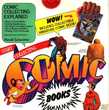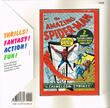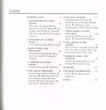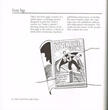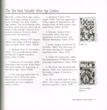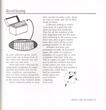Start Collecting Comic Books
Background
Back in 1990, Comic Collecting was HOT, HOT, HOT! With all those #1 alternate covers hitting the shelves, how could any savvy comic collector fail to make a fortune? But first, you'll need a bit of info on getting started in the brave new business of Collecting Comics!
As somebody who just fell into collecting comic books, and learned the ins and outs the hard way, it seems a little unfair to offer too much advice to newbies. But Harold Schechter seems prepared to spill the beans and help folks get started in "The King of Hobbies".
Story Details
Start Collecting Comic Books
| Publisher: | Running Press |
| Writer: | Harold Schechter |
| Contains Component: | Amazing Spider-Man Mini Comic (Running Press) |
This book by "Running Press" is a part of their "Start Collecting" series, which also includes "Coins", "Rocks", "Stamps", "Fossils", and "Baseball Cards". 100-odd pages of black and white book, 8" x 8" with a soft fold-over cover. A clear pocket in the back contains your "very first comic", a reprint of "Amazing Spider-Man #1", in 4.25" x 6.25" reduced size.
Yep, WE all know that in fact Amazing Fantasy #15 would be a better comic to have reprinted, but comic collecting in the 90's was all about "Number Ones". Heh, yeah, that whole idea turned out to be a big pile of "Number Twos", but we'll get to that.
Harold starts with a quick dash through the history of comics books. He dates comics from the 1896 appearance of the "Yellow Kid" in newspapers. A sprint through the Golden Age, the EC Years, the Silver Age, and the New Age, and here we are... modern day.
We get a quick anatomy of a comic... cover, banner, splash page, etc. Then there's a dash through the process of creation - i.e. writing, pencilling, inking, etc. Then the next chapter is "genres of comic books..." which are apparently "educational", "funny animal", "horror", "jungle", "romance", "super-hero", "war", or "western". At this stage, I definitely started getting the feeling that something was rotten in Denmark.
Let me explain. On the same day that I was scanning through "Start Collecting Comics", I had also begun reading Scott McCloud's "Understanding Comics". While McCloud was opening my mind to the near-infinite potential of perhaps the most exciting medium of the 20th century, here is Mr. Schlockburger chopping up the comics market into eight narrow-minded pigeon-holes. While Scott is describing a pan-dimensional spectrum and examining the tension between depth of writing and depth of art, here's Harold trying to reduce the wonderful world of comics to a few cliche'd categories.
Schecter continues to list the big-name publishers of the recent age, then leaps through a dozen or so of the big-name creators... a terrifying task of picking the great from the also-great. Schecter plays it safe and goes for the big names... the wonderful work done by the independent comics movement is carefully omitted in all of Schecter's comments. There's no "Fabulous Furry Freak Brothers" in this book!
Harold then talks a little about buying and selling comics. He talks about current issues, back issues, investing vs. selling. He then attempts to dissect "what makes a comic valuable", a daunting task indeed! Then there's a couple of "top-ten lists of the most valuable comics of the golden and silver ages". He lists prices for "Fine to Near Mint" grade. Whew! There's a bit of a range in there. A Near Mint book could be worth 10+ times a fine copy.
We finish up with a very vague and unimpressive guide on grading comics, and a few general hints on care and storage. There's a bit of a glossary, and a few references to other books, including of course the "Overstreet Guide". Then we're done. Time to unpack your sample ASM #1 reprint, and there ya go, you're a comic collector!
General Comments
This is the first dedicated guide to Comic Collecting that I can recall seeing, and to be fair, I suppose this is better than nothing. There are certainly some hints and bits of info that I could have well benefited from at age sixteen.
On the other hand, there are some huge generalisations and vague facts that may well end up doing more harm than good to an impressionable young future collector... from the wishy-washy grading guides to the vague "Fine to Near Mint" valuations. Heck, even on the cover you see a first grabbing an unbagged comic in a disturbingly spine-creasing fashion.
Furthermore, this book was written in 1990, right in the midst of the comic collecting craze, where anything with #1 and five variant covers was a "sure thing" for gaining value. Bandwagon-hopping "investors" were distorting the market left, right and centre, and were confusing the heck out of those of us that actually collected for the love of comics.
There's no real hard-core advice about comic dealers, pricing guides, or even anything useful like info on multiple-titles for characters. There's no info about getting caught out by reprints, no advice that often back issues are cheaper than new comics! There's nothing about how to handle comics to avoid common accidental damage, no big "NEVER USE TAPE" warnings. All-in-all, there's a hundred pieces of great advice that I would consider essential to a would-be comic collector, and none of them are in this book.
Plus, given the date, there's also nothing here about eBay, newsgroups, buying on the net. There's nothing about packing comics for shipping, the dangers of sunlight... oh... I could go on all day. I think you get the idea.
Overall Rating 

This book is better than nothing, but only just. But it could have been so much better still, and I can't give a decent rating to a squandered chance. One and a Half webs. Must try harder.
